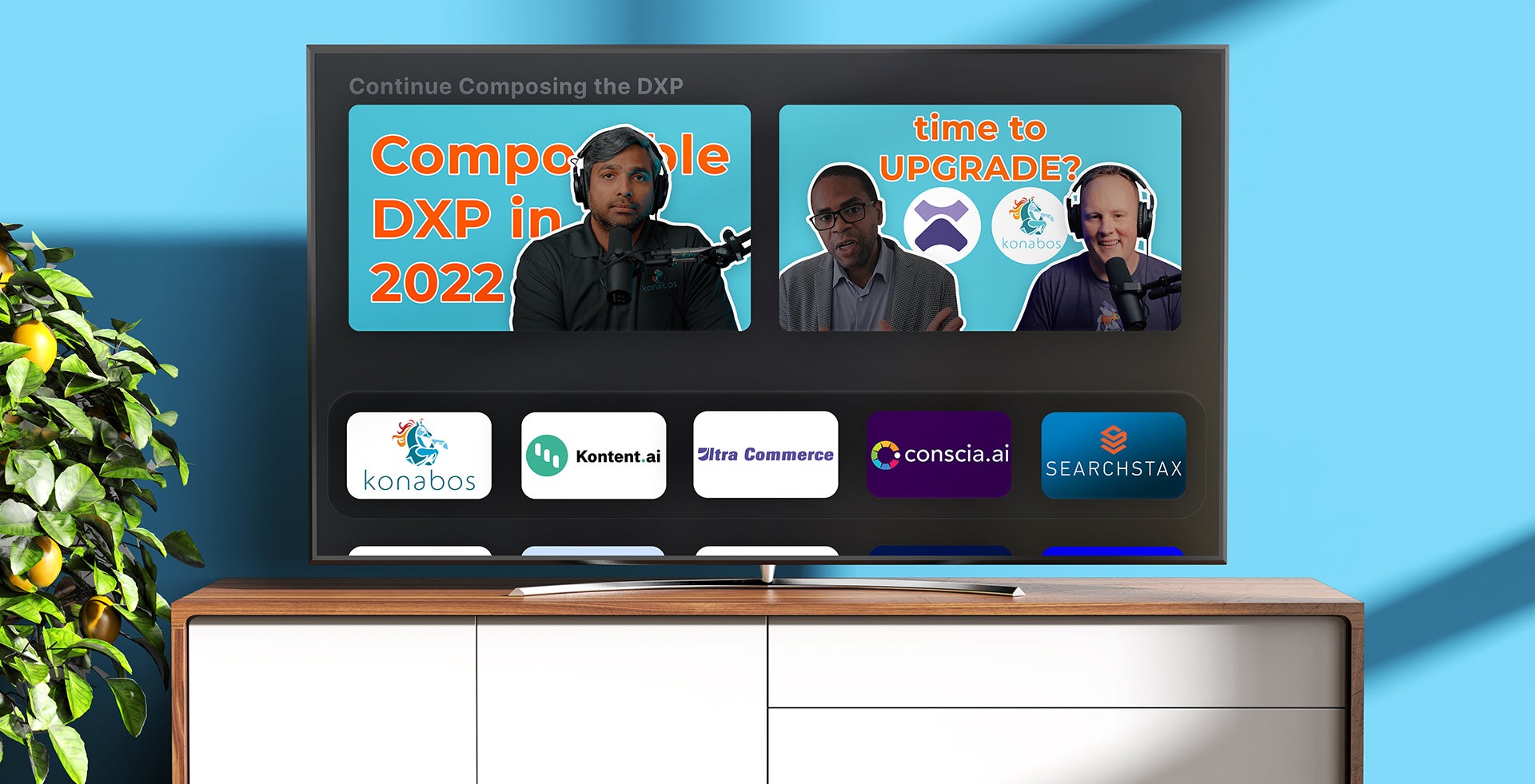Of Cord-Cutting and Composability
Matthew McQueeny - Relationships & Community Lead
4 Aug 2022
Transitioning towards Composable DXP - and composable business in general - is both exciting and anxiety-inducing. For an organization considering the move, the promise of best-in-breed options, agility, and speed-to-market is what whets the appetite. On the other side, contemplating how to move internal processes and operations from the monolithic here-and-now to the composable there-and-then could turn the stomachs of even the heartiest executives and managers.
Learning from other industry transformations
Sometimes it is important to look toward other kinds of businesses and industries for examples of how transformation can similarly take place. When pondering composable business, one of my favorite thought exercises is considering how the transformation that has happened in television, the internet, and the telephone – so-called “cord cutting” - is akin to or informs what we may see with the Composable DXP.
The pain and costs of being “boxed”-in
We now live in a time of television being delivered to us OTT, or “Over the top,” via internet connection. But it was only 15 short years ago that television was delivered through a “cable” connection, to an estimated 115 million U.S. households! That cable connection always came in a bundle called the Triple Play, accompanied by an internet and telephone connection as the other two legs of the package. This bundle was delivered and negotiated as a package by the cable company, creating its own version of a “monolith.” There was little competition because the cost-benefit of another cable provider hardwiring up an entire geographic area and then trying to compete with the incumbent on the triple play was just not worth the effort and cost. All the while, Triple Play costs only went up as the monolithic entities – dare we say, “Monopolies”? – had no real reason to drive costs down. For a TV consumer, there were no compelling alternatives, aside from getting rid of cable and reading more books. Plus, decoupling the monolith, to remove parts of the bundle, made the remaining products like phones and the internet more expensive than they were in the Triple Play configuration. Lastly, as the only player on the block, cable delivered everything a consumer would want on television.
Netflix disrupts the monolith and creates savings
Then came something called Netflix, and the recession of 2008. Before this point, internet-based video was consumed on a computer or laptop and Netflix was primarily delivering movies and television through the mail. Netflix began to disrupt that DVD-by-mail business with a streaming offering. It purchased the rights to hit shows and movies while simultaneously utilizing the data about its users to create its own content. Set-top box products like Roku and Apple TV came out, allowing users to move television and movie consumption back to the couch and onto their big screen. Internet-delivered television was becoming accessible and came with many of the analog television comforts, like a box and a remote control. User interfaces – the software and the presentation layer - improved drastically in these new form factors.
With the recession of 2008, consumers simultaneously began looking for ways to pare back spending. When they took note of a burgeoning internet video competitor in Netflix (and others purported to be on the horizons), they noticed substantial savings in “cutting the cord” and cancelling cable, which had become ever more bloated with hundreds of excess channels no one was watching and years-long subscription vendor lock-in. In addition, consumers were moving enthusiastically toward smartphones, imperiling the phone part of that Triple Play. Now the cable company offering was turning into a “single shot,” with customers maintaining internet only.
Composable cord cutting spurs innovation and adds more choice
With this newly best-of-breed and “composed” bundle, consumers could find substantial savings, maximal flexibility in pricing and access, and a better overall product. They could also consume in an omnichannel way, with second screens and strong native accessibility on mobile and tablet devices. Where once a consumer needed to buy an expensive cable box for each television in their house, the one streaming television subscription was now available by default across all manner of devices and smart television operating systems. That subscription also allowed consumers to take their TV outside of the home, something the cable companies often did not allow.
As we moved forward into this composable cord-cutting world, internet speeds improved to keep up with the expanding bandwidth of internet video, and costs came down on that front. Now that the monopoly was broken, competition was more available. Internet suitors could come in through alternate ways, such as satellite, phone line, and cell service. Subscriptions for services could be opted into month-to-month, maintaining the onus on the providers to keep serving the customer. Curation, personalization, and orchestration were superb within certain applications, such as Netflix and cable alternatives like Google’s YouTube TV.
As Triple Play cable providers watched their subscriber bases winnow away over the years, they attempted to ward off the decline and compete with the streamers. Individual channels from the bundle were decoupled and made available through cable authentication or direct-to-consumer subscription, like HBO, CBS (Paramount Plus), NBC (Peacock), AMC, Showtime, Disney, and more. Digital native companies simultaneously created their own channels, like Prime Video (Amazon), Apple TV Plus, and the aforementioned YouTube TV. Hybrids, like Hulu, also exist. This all led to a consumer-friendly but completely overwhelming 559 television shows produced in 2021!
When we look back to the initial savings gained, efficiencies, and clarity of the early cord-cutting era, where we find ourselves now might have you spinning in your recliner. That old expensive-looking cable television bundle of the Triple Play epoch now looks rather sensible when you add up a la carte subscriptions to Netflix (whose prices are also ascending), Peacock, HBO Max, Paramount Plus, Peacock, sports packages, etc. It might leave you wondering if it is just 2007 again, but with less conformity of experience (a benefit in this case), too much choice, and no orchestration across the now-disparate applications and experiences.
This all makes me want to play a Mad Libs-type game and install the names of digital experience companies and vendors for those digital entertainment ones above.
Cord cutting in the Digital Experience Platform industry
There has been a similar “cord cutting” in the DXP industry. Where once there were monoliths like Sitecore, Adobe Experience Manager, Optimizely, and more, trying (in perhaps a pyrrhic attempt) to provide a single-source platform – Triple Play! - for all your organization’s digital needs, now there are best-of-breed choices for each layer of the stack, from infrastructure considerations to experiences, to commerce, to personalization, and on. Each one of these “channels” or “apps” have multiple high-level competitors, focusing on you, the customer, with no vendor lock-in or prohibitive switching costs.
But similarly, a customer needs to consider the time it will take to assess and procure the best solutions, and especially the total cost of ownership (TCO). The all-in-one bundle provided by a single vendor is probably outdated but bundling in some fashion and intelligent API integration is still in play and crucial for your implementation. This begs a couple of questions:
- Is the former all-in-one bundled cost still more expensive than adding up the costs of all the layers of your composable DXP stack?
- Is the cost-benefit calculus taking into consideration the other non-monetary benefits, like resource pool and availability, technical debt, time-to-market, flexibility, future posture, and confidence in your solution?
With all the best-of-breed solutions adding up in your stack and connecting through API, that curation and orchestration between solutions could become as important as it is for that streaming television screen! This is where headless orchestration and personalization companies like Conscia or Uniform could enter your mix.
Might we also see some composable reformulation of the bundle? For instance, in the streaming world, Disney has a bundle that brings the customer Disney Plus, Hulu, and ESPN Plus at a discounted rate. Spotify offers a premium bundle for students that adds Hulu and Showtime. YouTube TV, Apple TV Plus, and Amazon Prime Video allow consumers to bundle premium channels – often at a discount – atop their platforms.
Composable bundling to simplify choice
In Composable DXP, there is great interoperability and connection – API’s! - between software solutions and vendors. But a logical next step is to potentially bundle services that constitute the layers of the composable technology stack. Perhaps there could be a starter kit for “CMS and internal site search” with Contentful, Contentstack, Kontent.ai and SearchStax or Coveo? Or a commerce and personalization package that includes UltraCommerce and Conscia? Or even a “super” bundle that brings CMS, commerce, search, personalization, and call it “The Grand Slam” stack? This could alleviate the “paralysis by analysis” that can arise when there are too many choices. Of course, you could always connect with an experienced Konabos composable professional to assist in simplifying the choices in front of you.
Stay agile and remain relevant
The key is – much like with cord cutting – to stay agile and current with the marketplace trends. You can no longer “set it and forget it” or “extend and pretend” with your technology stack... or your business operations, for that matter. Composability, like cord cutting before it, is a philosophy and an organizing framework, one which is where everything is headed. Once you set your mind on that fact, you will save on costs and headaches, maintain maximum agility, and set a foundation from which to thrive.

Matthew McQueeny
Matt is a digital marketing professional and web project manager with over 15 years of experience. He has worked with clients ranging from Fortune 500 to startups. Industries of digital project experience include healthcare, publishing, technology, telecommunications, education, retail, entertainment, manufacturing, and transportation. In 2023, Matt was awarded his first Sitecore MVP, in recognition for his work in the Sitecore community.
He loves the intersection of technology, marketing, and communications. Throughout his career, he worked with many licensed and open-source content management systems, in editorial, social media strategy and advertising, search engine marketing, lead generation, analytics, and podcasting.



Share on social media